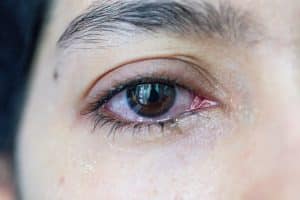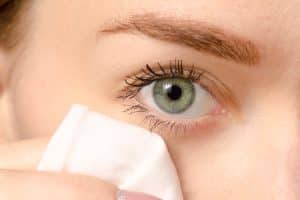Having dry, irritated eyes is bad enough at the best of times, but what’s worse is not knowing how to rectify the problem. This might be because you don’t know about the available solutions you can choose from, or it could be a slightly more complex issue created by not knowing what is causing the irritation.
Here, we explore the effects high levels of dust can have on your eye health, then look at simple solutions to help you get rid of dust-related eye irritation as soon as possible. Keep reading to learn more.
Can dust cause eye irritation?
The simple answer to this question is yes. Dust is known to be one of several potential causes of dry eye syndrome, a condition which can affect how many tears your eyes produce or how quickly those tears dry. Dry eye syndrome is associated with a range of uncomfortable ocular experiences including light sensitivity, watery eyes and blurry vision. One of the most notable effects, however, is an itchy or sore feeling in your eyes.[1]
Not sure if it’s dry eyes? There are other conditions which can be triggered or exacerbated by dusty conditions which may affect your eyes.
For example, although it might sound surprising, it’s actually possible to be allergic to dust. If this applies to you, you probably experience a form of allergic rhinitis – the same condition which causes hay fever. While hay fever sufferers typically experience discomfort only in certain months of the year when pollen levels are high, those who are sensitive to dust mites rather than pollen will likely find themselves affected all year round, although usually only indoors.
Dust allergies can trigger a range of side effects similar to those associated with hay fever, but the most important ones in terms of eye health are a dry, itchy sensation on the eye surface and increased tear production – i.e. watery eyes. Sound familiar?[2] This is also known as allergic conjunctivitis.
On top of that, in highly dusty environments, you can experience eye irritation without previously having a dust allergy or dry eye syndrome.[3]
Have you ever seen a film or TV show where a character opens a dusty old book and coughs as the dust billows up into their face? That’s because the dust is a physical irritant entering the throat and breathing passages, triggering a cough reflex. A similar principle applies to irritation of your eyes – dust particles reach the surface of your eye, causing discomfort, and your eyes water to try and wash the invading particles away.
The link between dust and eye irritation is usually nothing serious, but if you often find yourself with dry, itchy eyes even when you’re not in a particularly dusty environment, consider speaking with an optometrist about possible causes. There may be an underlying condition contributing to your discomfort that can be remedied.[3]
How to get dust out of your eye
If dust is exacerbating a condition like dry eye syndrome or allergic conjunctivitis, then eye drops specifically designed to tackle discomfort such as TheraTears® Irritation and Redness Eye Drops could help. This formulation contains the natural plant extract euphrasia to support natural eye whitening in the case of redness due to irritation.[4]
Important! If allergic rhinitis or a dust allergy is responsible for your irritated eyes, then you may experience other side effects such as sneezing, coughing, wheezing or congestion. Eye drops won’t help with these effects, but you can speak to a pharmacist about other treatments that could help to ease the discomfort.[2]
If you’re experiencing more severe irritation, this could be down to dust particles remaining on the surface of your eye and continuing to aggravate this sensitive area. If you suspect this may be the case, or that other irritants such as pollen, pet fur or mould particles may be having a similar effect, then it might help to flush the surface of your eye with clean water. Here’s how to do it:[5]
- Gather your equipment
Make sure you have everything you need to hand and within easy reach. Once you have water in your eye, it’s going to be harder to see what you’re doing, so having your equipment close by can help to reduce the risk of bruised shins or other accidents and injuries caused by looking for items while your vision is impaired.
The most important thing you’ll need is clean, lukewarm water – from a shower or tap ideally, but bottled water can work if you’re out and about. You might also find it helpful to have a clean washcloth or towel ready to dry your skin and hands, plus a cup to make it easier to apply the water to your eye if the tap or shower flow is too strong.
- Hold your eye open
Without touching the surface of your eye if at all possible, try to gently hold your eyelids open. Your natural reaction to water on the surface of your eye will be to close your eyes protectively, but unfortunately this can trap dust and other irritants in your eye.
- Run plenty of water over the surface of your eye for at least 20 minutes
Rinsing your eye can be uncomfortable, but it’s best to get it over and done with in one hit than to have to keep coming back because you’ve realised the irritant is still present.
In the majority of cases, those three steps should rinse any irritants out of your eyes. However, if you’re still experiencing irritation after rinsing your eyes, you should speak to your eye doctor as there may be a more serious problem causing the issue. You should also seek urgent medical attention if you experience additional eye problems or general feelings of unwellness following an eye injury.[5]
Resources:
[1] – https://www.nhs.uk/conditions/dry-eyes/
[2] – https://acaai.org/allergies/allergic-conditions/dust-allergies/
[3] – https://www.healthdirect.gov.au/itchy-eyes
[4] – Paduch, Roman et al. “Assessment of eyebright (euphrasia officinalis L.) extract activity in relation to human corneal cells using in vitro tests.” Balkan medical journal vol. 31,1 (2014): 29-36. Available at: https://pmc.ncbi.nlm.nih.gov/articles/PMC4115993/







